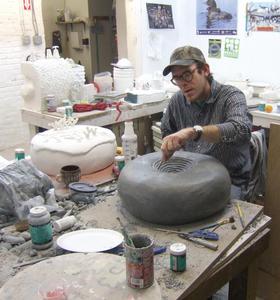

Peter Morgan says his work is influenced by pop art and the Funk movement (ceramics on the West Coast in the 1960s and '70s.
Peter Morgan, 33, is the son of Ed and Helen Morgan. Peter is currently the Evelyn Shapiro Foundation fellow at the Clay Studio in Philadelphia, Pa., where he works full-time as an artist. He has given lectures on his work at a numerous institutions in the U.S. and Beijing, and recently completed residencies at the Archie Bray Foundation in Helena, Mont. and the Belden Brick Factory in Sugar Creek, Ohio. Peter has taught at California State University in Long Beach and Gettysburg College in Pennsylvania. He has exhibited across the United States and Europe, and his work is in the permanent collections of the Shine Joseph International Museum of Ceramic Art, the California College of the Arts, The Archie Bray Foundation, and many private collections.
A 1996 graduate of Abingdon High School, he received a BA in Fine Art from Roanoke College, a BFA in Ceramics from the California College or Arts and Crafts, and a MFA in Ceramics from the New York State College of Ceramics at Alfred University.
"I took a ceramics class my sophomore year of college, when I was still unsure of what I wanted to do. I had a great connection with the medium and the professor; and I have worked with ceramics ever since," he says.
"My sculptural creations examine the world through an exploration of location, representation, perception, categorization, and language. The pieces illustrate and investigate what we know, and how we know it, through an exploration and celebration of cultural mythologies. Through my selection of topics, I create a sense of place and time through which the viewer may engage the work."
Peter notes, "One of my major influences is the Funk movement, which was primarily a ceramics movement on the West Coast during the 1960s and '70s. That was what prompted me to study at the California College of Arts and Crafts. Other influences include pop art and some of the early conceptual work by artists like Bruce Nauman. Lately I have also been into a lot of 'outsider' art as well as early nature illustrations."
Another aspect of Peter's artistic process is his curatorial work. He has curated several exhibitions in the past and will do some in the future. His most recent project was a nautically-themed exhibit in Florida last year.
Peter describes his sculpture as "more traditional" than the other two artists in "Color Me Bad." He says, "There is a thread of humor that runs through the practice of all the artists included that will decidedly be a unifying element. With great anticipation, I am looking forward to seeing the work the other artists are presenting and how it will make a cohesive exhibit.
"In my work, there is a humorous slant with plenty of room for social critique as my pieces are about the confluence of doughnuts, geology, and the extraction of natural resources. Viewing the world though the lens of the absurd, I seek to challenge our cognitive processes by creating connections between often seemingly disparate topics. Through the use of puns and analogies, I create links between entities via language and categorization. I am interested in how the mind makes connections and fills gaps of information, even though the vision may be absurd or fantastical. Through these explorations, I hope to come to a greater understanding of the world, how it is constructed, and why."
He continues, "My objects are often archetypal depictions focusing on our idealized understandings and desires of the subject, rather than their actuality. I think of my sculptures being collaged from an encyclopedia, a place where, in theory, all the information in the world is kept in a concise, ideal, and easy-to-read format. My pieces illustrate and investigate what we know and how we know it, through an exploration and celebration of cultural mythologies. Through my selection of topics, I create a sense of place and time through which the viewer may enter the work, physically and/or psychologically.
Frequently I utilize shifts in scale, transforming everyday objects into vast landscapes, and conversely massive objects into toy-sized replicas. Through this macro/micro shift, the work considers our experiences with everyday objects and those that are experienced vicariously through books and popular culture."